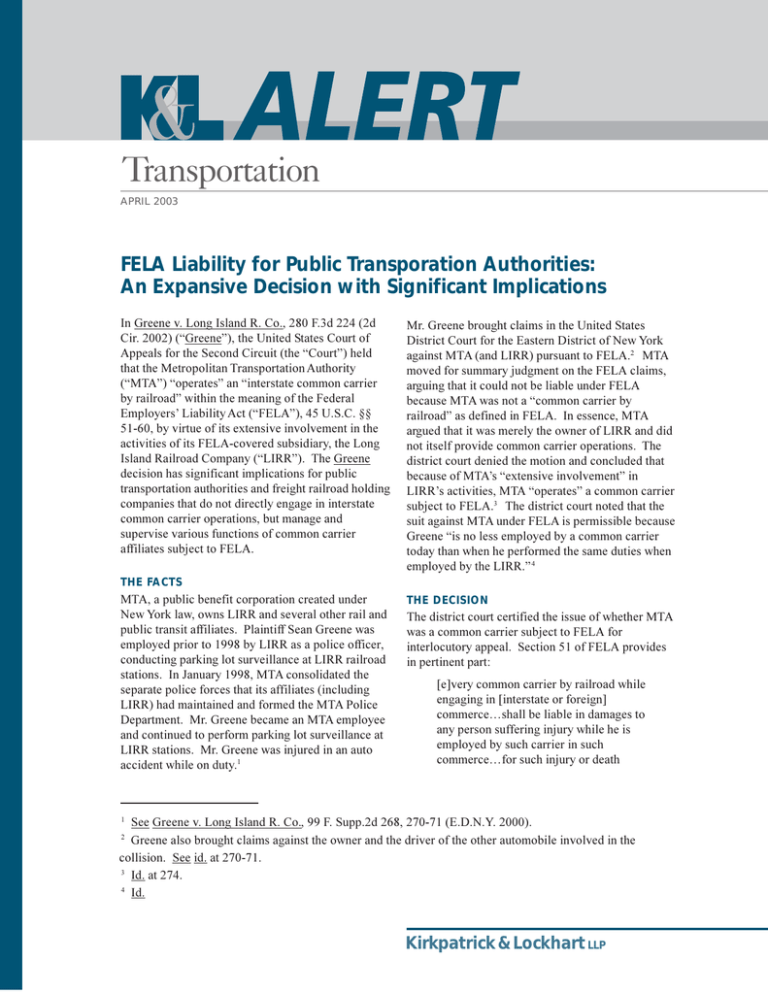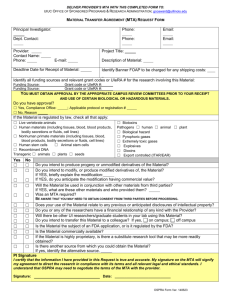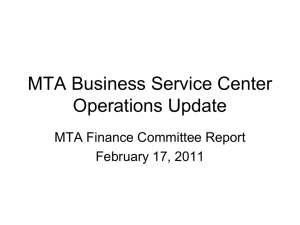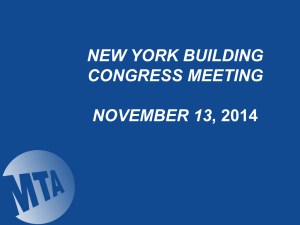
Transportation
APRIL 2003
FELA Liability for Public Transporation Authorities:
An Expansive Decision with Significant Implications
In Greene v. Long Island R. Co., 280 F.3d 224 (2d
Cir. 2002) (Greene), the United States Court of
Appeals for the Second Circuit (the Court) held
that the Metropolitan Transportation Authority
(MTA) operates an interstate common carrier
by railroad within the meaning of the Federal
Employers Liability Act (FELA), 45 U.S.C. §§
51-60, by virtue of its extensive involvement in the
activities of its FELA-covered subsidiary, the Long
Island Railroad Company (LIRR). The Greene
decision has significant implications for public
transportation authorities and freight railroad holding
companies that do not directly engage in interstate
common carrier operations, but manage and
supervise various functions of common carrier
affiliates subject to FELA.
Mr. Greene brought claims in the United States
District Court for the Eastern District of New York
against MTA (and LIRR) pursuant to FELA.2 MTA
moved for summary judgment on the FELA claims,
arguing that it could not be liable under FELA
because MTA was not a common carrier by
railroad as defined in FELA. In essence, MTA
argued that it was merely the owner of LIRR and did
not itself provide common carrier operations. The
district court denied the motion and concluded that
because of MTAs extensive involvement in
LIRRs activities, MTA operates a common carrier
subject to FELA.3 The district court noted that the
suit against MTA under FELA is permissible because
Greene is no less employed by a common carrier
today than when he performed the same duties when
employed by the LIRR. 4
THE FACTS
MTA, a public benefit corporation created under
New York law, owns LIRR and several other rail and
public transit affiliates. Plaintiff Sean Greene was
employed prior to 1998 by LIRR as a police officer,
conducting parking lot surveillance at LIRR railroad
stations. In January 1998, MTA consolidated the
separate police forces that its affiliates (including
LIRR) had maintained and formed the MTA Police
Department. Mr. Greene became an MTA employee
and continued to perform parking lot surveillance at
LIRR stations. Mr. Greene was injured in an auto
accident while on duty.1
THE DECISION
The district court certified the issue of whether MTA
was a common carrier subject to FELA for
interlocutory appeal. Section 51 of FELA provides
in pertinent part:
[e]very common carrier by railroad while
engaging in [interstate or foreign]
commerce
shall be liable in damages to
any person suffering injury while he is
employed by such carrier in such
commerce
for such injury or death
See Greene v. Long Island R. Co., 99 F. Supp.2d 268, 270-71 (E.D.N.Y. 2000).
Greene also brought claims against the owner and the driver of the other automobile involved in the
collision. See id. at 270-71.
3
Id. at 274.
4
Id.
1
2
Kirkpatrick & Lockhart LLP
resulting in whole or in part from the
negligence of any of the officers, agents,
or employees of such carrier, or by
reason of any defect or insufficiency, due
to its negligence, in its cars, engines,
appliances, machinery, track, roadbed,
works, boats, wharves, or other
equipment.
Section 57 of FELA defines the term common
carrier to include:
the receiver or receivers or other persons
or corporations charged with the duty of
the management and operation of the
business of a common carrier.
On appeal, the Court focused on the definition of
common carrier pursuant to Section 57 and
analyzed whether MTA is within the scope of FELA
as a manager or operator of LIRRs business. The
Court analyzed the extent of MTAs participation in
LIRRs business and concluded that MTA was
directly and integrally involved in the essential
business aspects of LIRRs operations. 5 The Court
found the following facts to be significant indicators
of such involvement:
1) MTA participates directly and extensively in
the financial side of LIRR operations by
performing budgeting, cash management and
other financial functions;
2) MTA is involved in advertising and marketing
for LIRR;
3) MTA provides subsidies for LIRR operations;
4) MTA provides certain real estate, risk
management and legal functions for LIRR;
5) MTA is directly involved in LIRRs
negotiations with labor unions; and
6) MTA plans and funds capital improvements for
LIRRs commuter rail services.6
The Court also noted that MTA was directly and
integrally involved in providing police services that
were directly in furtherance of LIRRs business as a
railroad.7 The Court further observed that prior to
consolidation of the police forces, LIRR police
officers were covered by FELA. The Court
specifically noted that one of the benefits that MTA
5
6
7
8
perceived it would receive as a result of
consolidation of the security forces
was having
the workers out from under the FELA system.8
Based upon the Courts analysis of MTAs
involvement in the business aspects of LIRRs
operations, the nature of the police services provided
by MTA, and Greenes status as an employee
covered by FELA prior to consolidation, the Court
held that MTA was a common carrier subject to
FELA liability with respect to the police officers
employed by MTA to provide security for LIRR
railroad parking lots.
IMPLICA
TIONS
IMPLICATIONS
The Greene decision has significant implications (in
the Second Circuit and in other circuits if it is
followed in other circuits) for public transportation
authorities that do not directly engage in interstate
common carrier operations, but are involved in the
essential business aspects of common carrier
affiliates subject to FELA. Even if a public
transportation authority is not a common carrier by
railroad in the traditional sense, it still may face the
risk of FELA liability. In essence, Section 57 of
FELA presents a way in which entities managing or
operating the business of a common carrier can be
subject to FELA liability.
Many public transportation authorities play a
significant role in the management and supervision of
common carrier affiliates subject to FELA. In
addition, financial and administrative considerations
often compel public transportation authorities to
consolidate services and perform common functions
for such entities. The Greene decision shows that
such participation might subject a public
transportation authority to the risk of FELA liability
if it does not: i) prevent or limit its personnel from
performing certain essential business functions (such
as railroad police services) for FELA-covered
common carrier affiliates; and ii) make certain that
such affiliates are equipped with the resources and
expertise necessary to operate and perform such
essential functions independently of the public
transportation authority.
In addition, before implementing organizational
changes (such as consolidating services for FELAcovered carrier affiliates), public transportation
authorities should consider whether such changes
See Greene, 280 F.3d at 239.
See id. at 236-39.
Id. at 239.
Id.
Kirkpatrick & Lockhart LLP
2
expose the transportation authority to the risk of
FELA liability. Although Greene did not turn
explicitly on the fact that the plaintiff continued to
perform the same railroad services for LIRR after the
consolidation, the decision suggests that the Court
was influenced by this factor.
The Greene decision also has significant implications
(in the Second Circuit and wherever else it is
followed) for freight railroad holding companies that
do not directly engage in interstate common carrier
operations, but are involved in the essential business
aspects of common carrier affiliates subject to FELA.
Just as with public transportation authorities, if a
freight railroad holding company is actively involved
in operations or management of its subsidiary freight
railroad, the holding company could be subject to
FELA liability by virtue of Section 57 of FELA.
Unless the Supreme Court reverses or narrows the
scope of the Greene case, the implications of Greene
in the Second Circuit and anywhere else it is
followed will remain significant for public
transportation authorities and freight railroad holding
companies that manage and supervise various
functions of common carrier affiliates subject to
FELA.
TRACIE D. SPEAR
202.778.9390
tspear@kl.com
EDWARD J. FISHMAN
202.778.9456
efishman@kl.com
FOR FURTHER INFORMATION, please consult one of the lawyers
CONCLUSION
The MTA has filed a petition for certiorari with the
Supreme Court on the Greene case. In addition to
arguing that the Greene decision conflicts with
applicable precedent in other circuits that nonoperating entities are not subject to FELA, MTA
argued that it is immune from FELA suits in federal
court under the Eleventh Amendment.
listed below:
Boston
Harrisburg
Pittsburgh
Jeffrey S. King
Carleton O. Strouss
Theodore A. McConnell
Stephen M. Olson
San Francisco Robert J. Sherry
Washington Edward J. Fishman
Kevin M. Sheys
617.261.3179
717.231.4503
412.355.6566
412.355.6496
415.249.1032
202.778.9456
202.778.9290
jking@kl.com
cstrouss@kl.com
tmcconnell@kl.com
solson@kl.com
rsherry@kl.com
efishman@kl.com
ksheys@kl.com
®
Kirkpatrick & Lockhart LLP
Challenge us.
®
www.kl.com
BOSTON
n
DALLAS
n
HARRISBURG
n
LOS ANGELES
n
MIAMI
n
NEWARK
n
NEW YORK
n
PITTSBURGH
n
SAN FRANCISCO
n
WASHINGTON
............................................................................................................................................................
This publication/newsletter is for informational purposes and does not contain or convey legal advice. The information herein
should not be used or relied upon in regard to any particular facts or circumstances without first consulting a lawyer.
© 2003 KIRKPATRICK & LOCKHART LLP.
ALL RIGHTS RESERVED.






